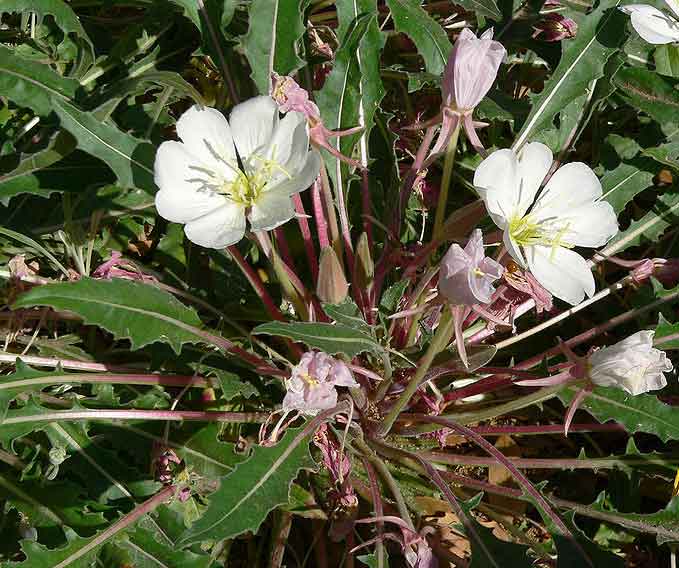
Oenothera cespitosa (*)
Classification System: APG IV
Superregnum: Eukaryota
Regnum: Plantae
Cladus: Angiosperms
Cladus: Eudicots
Cladus: Core eudicots
Cladus: Rosids
Cladus: Eurosids II
Ordo: Myrtales
Familia: Onagraceae
Subfamilia: Onagroideae
Tribus: Onagreae
Genus: Oenothera
Sectio: O. sect. Pachylophus
Species Oenothera cespitosa
Subspecies: O. c. subsp. cespitosa – O. c. subsp. crinita – O. c. subsp. macroglottis – O. c. subsp. marginata – O. c. subsp. navajoensis
Name
Oenothera cespitosa Nutt., 1813.
Synonyms
Homotypic
Pachylophis cespitosa (Nutt.) Raim., Nat. Pflanzenfam. 96 [III,7]: 215. 1893
References
Nutt., 1813. Cat. Pl. Upper Louisiana no. 53.
Tropicos.org. Missouri Botanical Garden. 22 Sep 2011 [1].
USDA, ARS, National Genetic Resources Program. Germplasm Resources Information Network - (GRIN) [Online Database]. [2]
enothera caespitosa, known commonly as tufted evening primrose, desert evening primrose, rock-rose evening primrose, or fragrant evening primrose, is a perennial plant of the genus Oenothera native to much of western and central North America, in habitats such as talus slopes and sandy plains.[1] It is normally night-blooming.[2]
The plant is considered good for rock gardens. There are many subtaxa, referred to as subspecies or varieties.
Description
Oenothera caespitosa grows to 10 centimeters (4 inches) tall. It produces a rosette of lobed or toothed leaves each up to 36 centimetres (14 in) long around a woody caudex. It has no stems, with flowers and leaves growing directly from the root crown.[1] The four-petaled white flowers open at dusk and wilt the next morning, turning pink.[3] The petals measure up to 5 cm (2 in) in width and length.[1] A notch gives them a heart shape.[1]
Ecology
The plant is a larval host to the white-lined sphinx moth.[4]
Oenothera caespitosa is dependent on hawkmoths, including the five-spotted hawkmoth (Manduca quinquemaculata) for pollination.[5]
Similar species
Oenothera deltoides is very similar, with short stems and slightly smaller flowers.[1]
References
Taylor, Ronald J. (1994) [1992]. Sagebrush Country: A Wildflower Sanctuary (rev. ed.). Missoula, MT: Mountain Press Pub. Co. p. 46. ISBN 0-87842-280-3. OCLC 25708726.
The Xerces Society (2016), Gardening for Butterflies: How You Can Attract and Protect Beautiful, Beneficial Insects, Timber Press.
"Botanica. The Illustrated AZ of over 10000 garden plants and how to cultivate them", p. 612. Könemann, 2004. ISBN 3-8331-1253-0
The Xerces Society (2016), Gardening for Butterflies: How You Can Attract and Protect Beautiful, Beneficial Insects, Timber Press.
Hodges, Scott A. "Some preliminary Observations on Hawkmoth Pollination of Oenothera caespitosa and Mirabilis multiflora" (PDF): 244–249.
Retrieved from "http://en.wikipedia.org/"
All text is available under the terms of the GNU Free Documentation License

